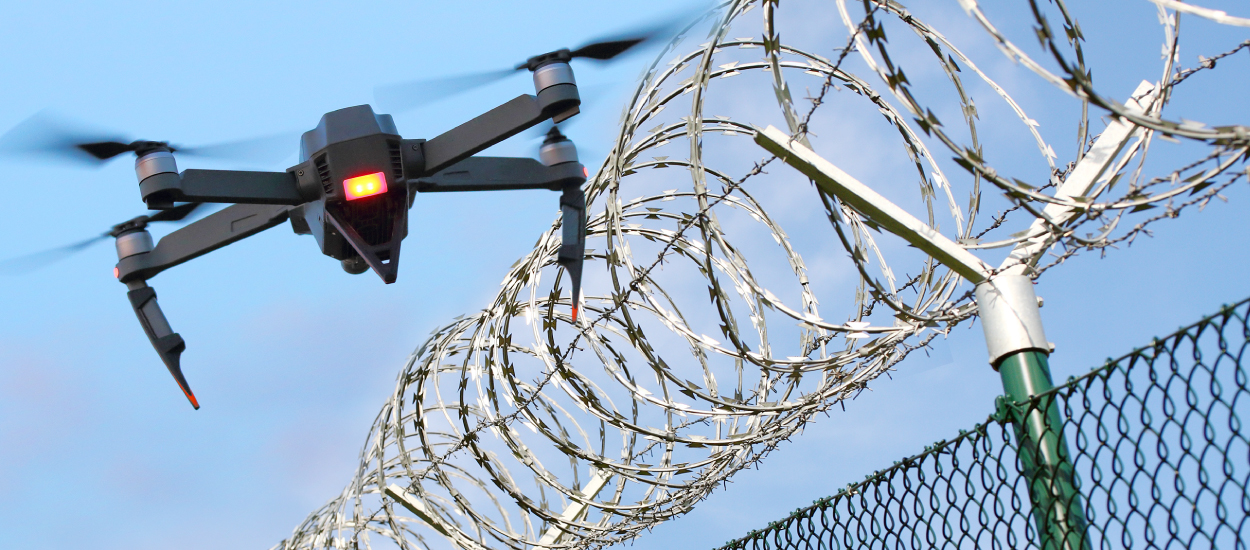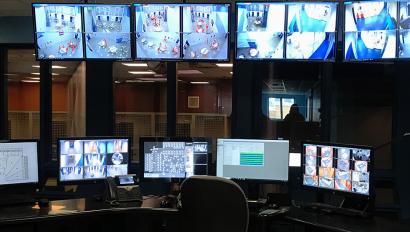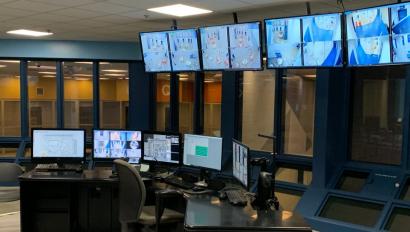How Correctional Facilities Can Use Drone Detection Tech to Stop Contraband Delivery

Jails and prisons are facing new threats from unmanned aircraft – more commonly known as drones – which are delivering weapons, drugs and other contraband over the fences and directly into correctional institutions. As sophistication and capabilities of drones increase, so too are the threats to these facilities.
But there are a number of technologies that correctional facilities can use to detect drones and potentially stop them from delivering contraband. First, however, let’s start with what a drone mitigation strategy looks like.
4 Steps in a Correctional Facility’s Drone Mitigation Strategy
Detection
Detection is the first stage of a drone mitigation strategy. Identify possible objects entering your space that may be a threat. These objects may include drones, birds or other aircraft.
Verification
Verification of the drone threat is next. In other words, verifying that the detected object is, indeed, a drone. Birds and other non-drone objects are filtered out during this step. Information about the drone also might be obtained, including the manufacturer or serial number. These two pieces of information are useful in determining the capability of the drone and how often it has visited.
Tracking
Tracking is the next step in the process. In this step, you record information about the position of the drone. You would want to know where it is, where it was, how high and for how long. This information will help direct searches to certain areas.
Alerting
The final step in a drone mitigation strategy is alerting the staff of an unmanned aircraft threat. After the threat has been detected and then verified, the facility can institute their response plan. When a drone enters your area and an alarm is sounded, your procedures take over. This can include stopping all movement and deploying teams to find and observe the drone and another team to search the area below for the drop. Communication of the current and past locations can be shared to enable a thorough search of the affected areas.
How Correctional Facilities Can Detect Drone Threats
These are the four primary detection technologies that are available to detect drone threats: radar, acoustic, RF sensors and optical. Each can be used on their own or in tandem to improve accuracy.
- Radar – This technology uses radio waves to detect and track airborne threats. A single station has adequate range to cover most large prisons. Radar is very good at tracking multiple objects at the same time in most weather conditions but may be subject to a higher amount of nuisance alarms due to birds. New capabilities used by some, including machine learning and artificial intelligence, can help reduce these nuisance alarms.
- Acoustic – The sounds produced by drones are detected by microphones and this information is processed to determine if a drone is in the area. The tracking ability of acoustic systems is less than some of the other technologies, but basic information about initial location and direction can be obtained. Noisy environments may also present additional challenges for facilities looking to solely use an acoustic detection system.
- RF Sensors – Radio frequency detection uses antennas to sense the communications between the drone and the remote operator. Detection range with this technology is very good but is limited to certain frequency ranges. If the drone operates outside of the system’s detected frequencies or is autonomous, the drone will not be detected.
- Optical – Optical, or video-based detection, relies on cameras and their field of view. Object and motion detection analytics can assist with detection, but line of sight is always required. Weather conditions and darkness can impact overall reliability of video-based detection alone.
Multiple technologies can be combined to improve the detection, accuracy and tracking ability of the overall combined system. For example, combining radar and optical can improve the performance. The radar can aid the cameras with tracking the drone and the video can help validate if the object is a drone or bird. In addition, cameras are a valuable tool for collecting evidence about each event. The recorded video can also be used for training and evaluating the effectiveness of the local response.
Many of these systems can be installed as a permanent or a mobile or portable solution. A permanent installation can help protect an existing institution on an ongoing basis. A portable solution could be deployed to help evaluate the threat and determine the number of incidents and types that may be occurring.
Current Outlook on Drone Detection
Drone countermeasures in the United States are limited due to current regulations and liability concerns. Jammers, electronic magnetic pulse or active net deployers all have practical real-world challenges and concerns. A proactive detection approach with well-designed local response procedures may be the most efficient and cost-effective solution.
The number of drones is increasing and their capabilities are improving. Use of remote-controlled and autonomous unmanned aircraft will continue to increase and the threat of drone use to deliver contraband at correctional institutions no doubt will as well. So the question remains: How is your facility combating this threat?
Learn more about corrections security solutions
Disclaimer: By using the Blog section of this website (“Blog”), you agree to the terms of this Disclaimer, including but not limited to the terms of use and our privacy policy. The information provided on this Blog is for information purposes only. Such information is not intended to provide advice on your specific security needs nor to provide legal advice. If you would like to speak to a Security representative about your specific security needs, please contact us.
























